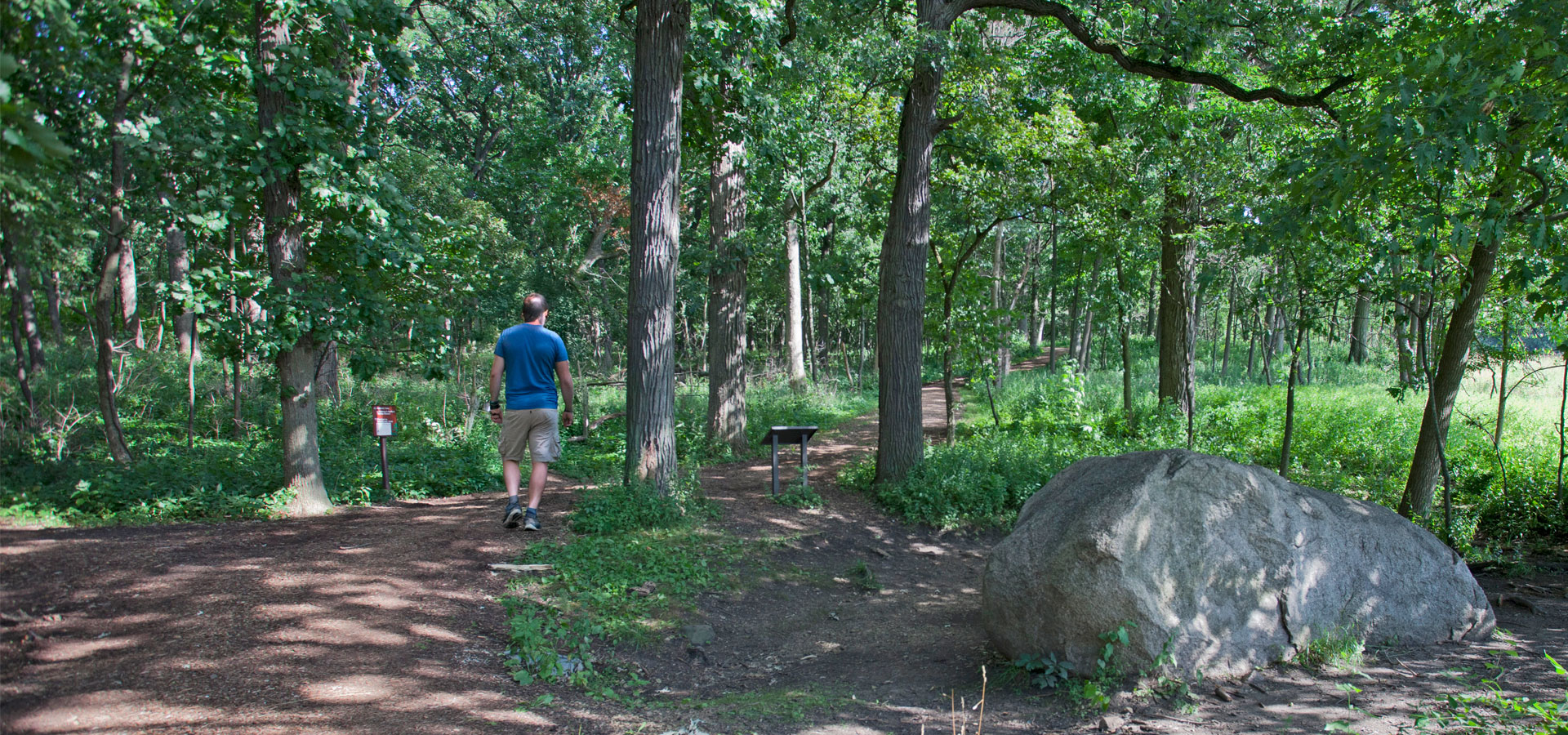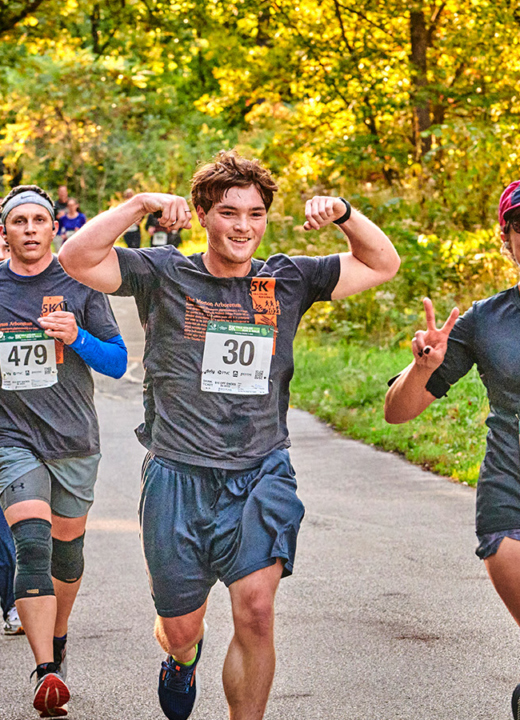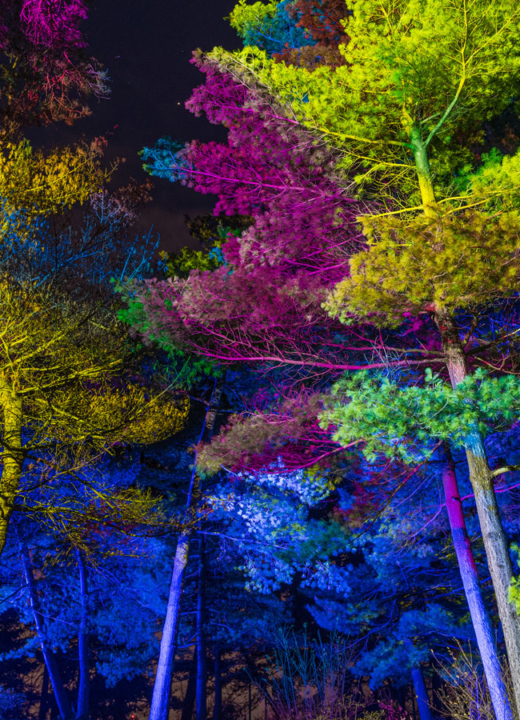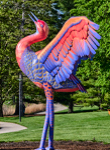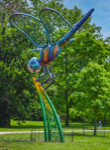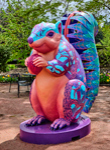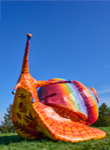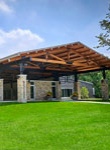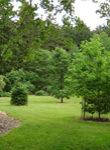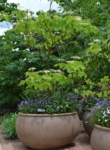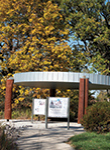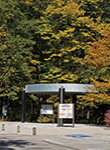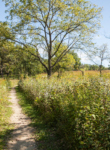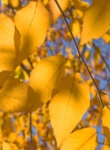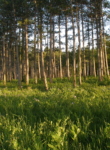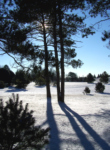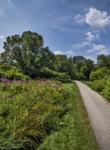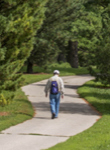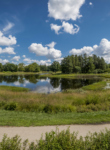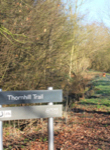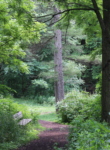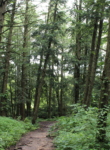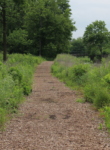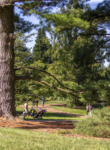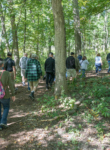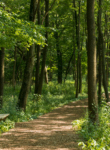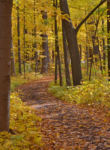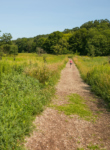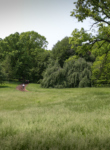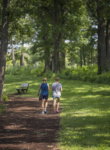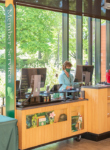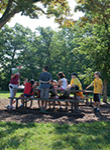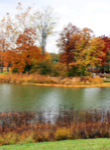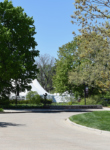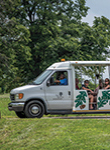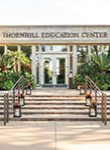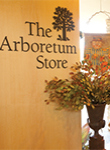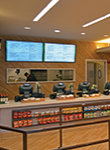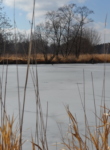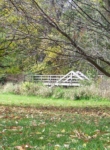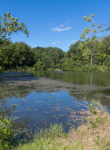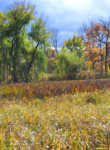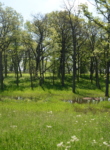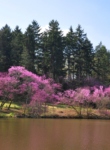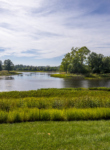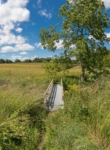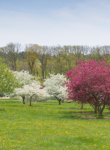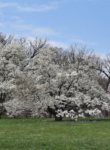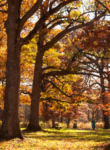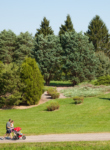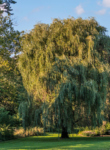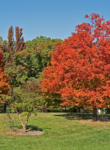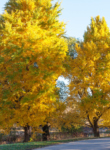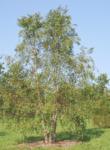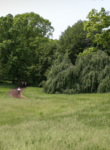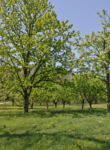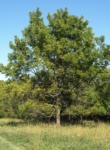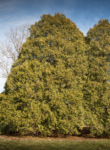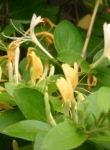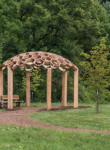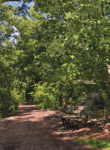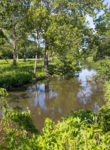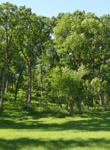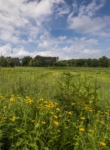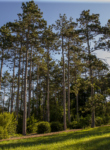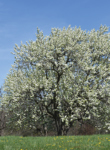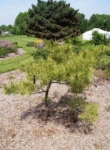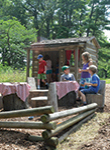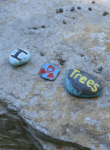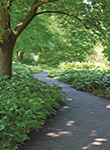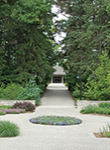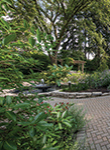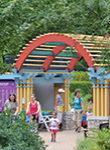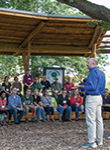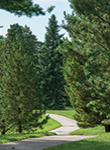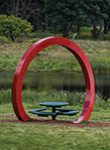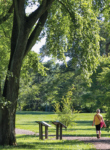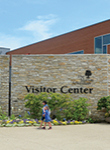The Big Rock Member Trail Mixer invites members of The Morton Arboretum to savor the beauty of autumn with activities and hikes centered around the Big Rock Visitor Station and the trails of the Arboretum’s East Woods on Sunday, October 5, from 10:00 a.m. to 2:00 p.m.
Whether you’re new to the Arboretum or have visited many times before, this free event is a great way to connect with fellow members and explore some of the Arboretum’s 16-mile network of trails.
Highlights
Explore the Arboretum
Stop by the “Animals of the Woodlands” station in the Visitor Center to learn about the creatures that live at the Arboretum and then look for signs of them along the trails.
Visit the “Geology of the Arboretum” display at Big Rock Visitor Station to discover how geological history is written in the Arboretum’s landscape.
Enjoy a self-guided hike near Big Rock. Follow a specially created map to learn how the Arboretum’s natural landscape, and our management of it, has changed over time.
Complimentary Snacks and Discounts
Check in at the welcome table in the Visitor Center on Sunday, October 5 to pick up a special Big Rock Member Trail Mixer map, a complimentary drink and snack (while supplies last), and to be entered into a drawing to win four AnyDay Tickets to Illumination: Tree Lights at the Morton Arboretum.
Members also receive a discount coupon for 10% off purchases made at the Ginkgo Café and the Ginkgo Restaurant. Discount coupons are valid on Sunday, October 5 only. Tree Advocate-level members and above receive 15% off.
Parking and Shuttle Service
Shuttle service is available between the Visitor Center Circle Drive near parking lot P-1 and the Big Rock Visitor Station beginning at 10:00 a.m. on a first-come, first-served basis.
Shuttle pick up and drop offs are expected every 10 minutes. The last pick up from the Visitor Center Circle Drive is at 1:00 p.m. and the last pick-up from the Big Rock Visitor Station is at 2:15 p.m.
Limited parking is also available near the Big Rock Visitor Station in parking lots P-8, P-11, P-12, P-13, and P-14.
Registration
The Big Rock Member Trail Mixer is a free, drop-in event open to Arboretum members.
A limited number of spaces were available for guided hikes, requiring advanced registration. All guided hikes are sold out.
Your membership supports the Arboretum’s vision of a greener, healthier, more beautiful world where people and trees thrive together.
Highlights
The upcoming Big Rock Member Trail Mixer will explore the Big Rock Visitor Station and the surrounding trails on Sunday, October 5, 2025.
Visit the “Geology of the Arboretum” display at Big Rock Visitor Station to discover how geological history is written in the Arboretum’s landscape.
Visit the “Animals of the Woodlands” station in the Visitor Center to learn about the creatures that live at the Arboretum and then look for signs of them along the trails.
Self-Guided Hikes
Hike the Heritage Trail and Woodland Trail while learning about the evolution of the Arboretum’s landscape and how Big Rock displays the unique geology of northern Illinois.
Follow a special map marked with hidden gems and points of interest near Big Rock Visitor Station, the Heritage Trail, and the Woodland Trail.
A map for the Big Rock Member Trail Mixer on Sunday, October 5, will be available online closer to the event date. A printed map will be available to pick up at the Visitor Center or the Big Rock Visitor Station on the day of the event.
Guided Hikes
Follow a naturalist guide through the trails and listen to stories of the landscape’s transformation over time—from ancient glacial shifts and early human settlement to the Arboretum’s present-day leadership in tree science, conservation, and education.
Guided hikes will leave from Big Rock Visitor Station every 30 minutes starting at 10:30 a.m. The last hike leaves at 1:30 p.m.
All guided hikes are sold out.
Map
Follow the points of interest below on the Big Rock Member Trail Mixer map to be guided through a tour of the landscape and history of the Arboretum’s East Woods.
More than 12,000 years ago, glaciers covered Illinois. Some, up to 2,000-feet thick, levelled the land and deposited soil and rocks far from their original locations. When the ice retreated, rocks of non-native stone, known as glacial erratics, were left behind. Big Rock is a granite boulder that is the largest glacial erratic at The Morton Arboretum. It is likely from northern Wisconsin or Canada. Whether large or small, these erratics show how ice shaped this landscape.
Notice the depression in the land as you look southwest beyond this sign. The depression, known as a kettle, was created when a block of glacier ice detached and was buried by glacial sediment. As the glacier retreated, this buried ice slowly melted, leaving a depression in the earth. Try and spot the small glacial erratic as you look across the kettle.
2—Perus Barney Road and Sawmill
The Perus Barney Road, now this Arboretum access road, was a popular route through woodlands and farmland leading to an 1800s sawmill owned by early settler Perus Barney. Logs harvested from surrounding woodlots were hauled here by oxen or wagon, shaping the early economy and clearing land for farming and homes. Follow this road to connect with the Heritage Trail further north, or continue along the path. Either route will take you to the site of the sawmill, now a bridge over the East Branch of the DuPage River that can be seen through the fence at the Hidden Lake Forest Preserve.
3—Foundational Stones
You are standing near a former stone quarry. Stone from this site was used in constructing Thornhill, the country estate of Arboretum founder Joy Morton, completed in 1910.
Morton’s years spent managing the estate, and its wooded landscape kindled his commitment to tree preservation, leading to the Arboretum’s creation.
A portion of the original estate is maintained as the Thornhill Education Center, which extends the Arboretum’s legacy of plant research, conservation, and education.
4—Prairie Restoration
The land before you is an ongoing restoration, following best practices exemplified in the Arboretum’s Schulenberg Prairie, one of the first efforts in the United States to return farmland to its natural prairie ecosystem. The Arboretum aims not to recreate a pre-colonial landscape, but to recover healthy populations of native plant and animal communities on the land.
Native biodiversity creates robust, thriving ecosystems that are more resilient to new challenges—such as ongoing climate change, surrounding development, and invasive plants, pests, and pathogens.
In the late-1800s, trees, stumps, and stones from this field were cleared for farming—in some instances with considerable effort. The 14-ton Big Rock was moved to its current location by the family who owned the land at the time—and some strong draft horses!
Woodland Trail
5—Productive Land
The lands that comprise the Arboretum were used for farming, grazing, and timber for nearly a century before its founding in 1922.
Many areas throughout the East Woods, like the one you are standing in now, were managed to be productive. Indigenous groups, most notably the Pottawatomie, established villages in this area and used the land for agriculture, hunting, and fishing. They used controlled burns to manage the land, a practice the Arboretum still uses today.
As settlers moved east across the prairie, wooded parcels between 5- to 40-acres were often granted to families separately from prairie farms, which provided essential resources like firewood and lumber that could not be found on the open prairie. This part of the East Woods would likely have been former woodlots.
6—Repurposed for People
A natural part of land management, trees may need to be removed to better a forest ecosystem or ensure the safety or Arboretum visitors. Arboretum arborists sometimes transform the stumps into tree thrones—seats carved with chainsaws from the remaining trunk. These whimsical features are one of the countless ways the Arboretum manages its landscape to encourage people to connect with and enjoy trees.
Sit and rest a while, or gather for a fun photo opportunity.
Another way the Arboretum is transforming felled trees is by turning them into sustainable lumber used in the creation of tribute benches throughout the Arboretum.
7—Part of a Living Collection
Unique from other gardens, The Morton Arboretum was envisioned as a great outdoor museum of trees arranged for scientific study. Each tree recorded in the Arboretum’s living collection—more than 100,000 specimens and counting—receives a specialized tree tag.
Tags record vital information about the tree’s origins and care, and can aid scientists in long-term research. Look for tree tags on the south side of a tree at eye level.
When naturally-occurring trees are added to our collection, “origin” and “year added” are marked as “U” for unknown.
8—Learning from the Litter
A sign of research that benefits people and trees, Arboretum scientists place these leaf litter baskets in wooded areas to study nitrogen cycling in forest ecosystems. Collected leaves, seeds, and even bugs are analyzed for how much nitrogen and carbon is added to the soil through falling material, and how the nutrients impact surrounding ecosystems.
Monitoring rain funnels also track atmospheric nitrogen, a critical nutrient that can stress forest health when delivered in excess through fossil fuel burning or over-applied in farming.
You’ve reached the end of the Big Rock Member Trail Mixer self-guided tour! We hope that you enjoyed your walk through the East Woods and learned something new about The Morton Arboretum’s magnificent landscape.
As a member, you can visit The Morton Arboretum any day without purchasing general admission. Visit again throughout the year to see the landscapes change with the seasons and enjoy the best of the Arboretum as a member.
Your membership supports the Arboretum’s vision of a greener, healthier, more beautiful world where people and trees thrive together.
Thank you for your support.
Food Options
Stop by the Visitor Center on Sunday, October 5 to receive a complimentary drink and snack, available while supplies last.
Arboretum members receive a coupon for 10% off at the Ginkgo Café and the Ginkgo Restaurant, valid only on Sunday, October 5. Tree Advocate-level members and above receive 15% off.
Check in at the Big Rock Member Trail Mixer welcome table in the Visitor Center to receive your coupon.
Food and beverages are available at the Ginkgo Restaurant and the Ginkgo Café, both located in the Visitor Center. The Ginkgo Restaurant is open from 11:00 a.m. to 2:00 p.m. From 9:00 a.m. to 6:00 p.m., the Ginkgo Café offers prepackaged salads and sandwiches, bakery items, espresso beverages, hot tea, and drip coffee.
Accessibility
Accessible parking is available at parking lot P-13.
There are accessible portable toilets and hand-washing stations.
A short loop, beginning and ending at the parking lot, is paved with textured concrete and is accessible to strollers, wheelchairs, and walkers. The other trails that converge at the Big Rock Visitor Station, including the Heritage Trail, the Woodland Trail, Main Route Loop 3, and Main Route Loop 4, have a surface of loose wood chips and are not accessible to wheelchairs and walkers.
